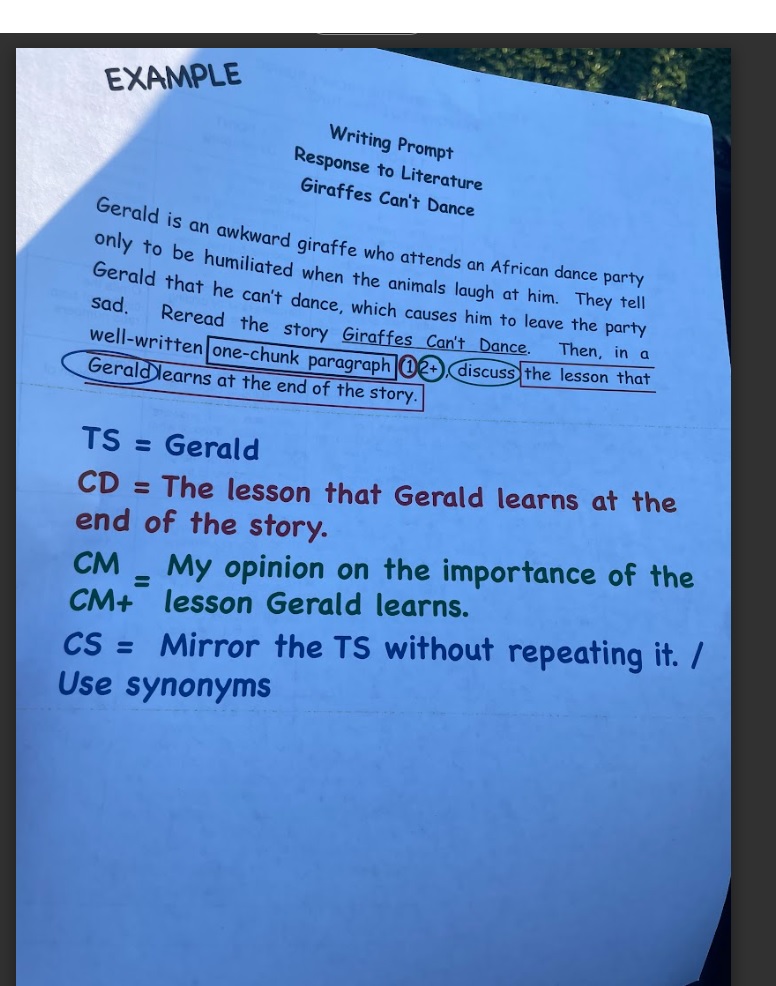Does Your Prompt Actually Prompt?
DECODING A WRITING PROMPT
We have all heard students exclaim, “I don’t know how to start!” The Jane Schaffer Writing Program® (JSWP) was designed by Jane to remove that thought from their minds. From the prompt to the final draft, JSWP teaches students the cognitive thinking process behind the execution of writing.
Let’s start with the prompt.
We have found that students encounter difficulty in writing because they do not understand how to “decode” or “deconstruct” writing prompts. Once students understand our color-coding system, we teach them how to use it to comprehend what a prompt is asking.
Guidebooks 2.o Sixth Grade Prompt Hatchet
Select an event from Hatchet. What did Brian do to aid or hinder his survival? Does Hatchet have instructional value as a survival guide?
Write a multi-paragraph report explaining how Brian was successful and/or could have improved his situation if he had followed the steps provided in the article case studies. Conclude the report by making a claim and providing clear reasons and evidence about the instructional value of Hatchet. Be sure to use proper grammar, conventions, spelling, and grade-appropriate words and phrases. Cite several pieces of textual evidence, including direct quotations and page numbers.
"What Are They Asking Me to Do? Decoding the Prompt"
Introduction and Thesis Statement: In the JSWP, we teach students to start with a broad, thematic, universal idea about the human condition. For example, what is meant by success? Start your introduction by answering that question. Then, narrow the introduction, observing the fictional idea and nonfictional texts that deal with the concept of survival as success. The thesis has the potential of being two-fold: Was Brian successful and/or could he have improved his situation? This is the key question, and from this question the student will derive the first part of the thesis statement. The second part of the thesis statement will defend or challenge the idea that Hatchet is of instructional value. Because of the complexity of the questions, the thesis should probably be a compound sentence (a compound-complex sentence, if the teacher wants a counterargument regarding the argumentative portion of the assignment). The thesis may be a framed thesis in which the writer names his/her reasons, which will lead to the topic sentences or an open thesis that “hints” at the topics. We teach all of this in the Jane Schaffer Writing Program.
Topic Sentences (TS): Topic sentences provide reasons that support a writer’s thesis. From where in the prompt could topic sentences come? Options abound: (1) each body paragraph could begin with a TS that names different successes that Brian experiences that aid his survival (beginning writer); or (2) perhaps the student would like to focus on what Brian did that hindered his survival and how he could have improved on that situation (intermediate writer); or, (3) perhaps a student wants to approach main ideas that emerge from the article case studies and use that concept to lead the discussion (advanced); or (4) a combination (highly advanced).Since this prompt requests two different modes of discourse, literary analysis and argumentation, the student will end his report with one or two body paragraphs. In that case, each TS will be the writer’s claim with a “clear reason” about the instructional value of Hatchet.
Concrete Details (CDs): In this assignment, concrete details (evidence) are derived directly from the multiple texts (not other forms of evidence which we discuss in our trainings). That evidence will come from Hatchet and the articles. Using the “Evidence Chart,” students will write the concrete details in red. We recommend teaching students how to embed quotations while they read rather than paraphrasing at the 6th grade level. You’ll also notice that we place the prompt as well as key ideas on the “Evidence Chart” to keep the students focused. Once the reading has been completed, discerning which pieces of evidence are the most important is an essential skill that we teach.
Commentary (CDs): Commentary is always the most difficult to teach because it asks for students to give insight into their reading and provide interpretations about life and the human condition as well as the significance of the evidence as it pertains to the thesis and the topic sentences. Thus, it must be both insightful and logical. We teach students how to take the ideas of a prompt (abstract nouns, powerful verbs, etc.) and Web-off-of-the-Word™ in order to make inferences about the selection of evidence and how those inferences relate to the prompt, the thesis, and the topic sentences.
Concluding Sentence (CS): In an academic body paragraph, each body paragraph must have a concluding sentence. Concluding sentences come from commentary ideas that provide a finished feeling to the body paragraph. For 6th graders, we tell the students that the concluding sentence is a reflection of the topic sentence but does not use any of the same words.ArgumentationThis particular assignment has an argumentative piece in the final section, so we must teach students how to take the different parts of an academic body paragraph and build the claim, concession, counterargument, and refutation. The latter three may not be necessary at the sixth grade level.The ConclusionThis particular assignment does not end with a traditional, classical conclusion since it combines two modes of discourse. If we were to teach the conclusion, we would start with a restatement of the thesis (not a repeat) and broaden the idea to the significance of the assignment. That task is actually being accomplished in the second half of the assignment through argumentation.






